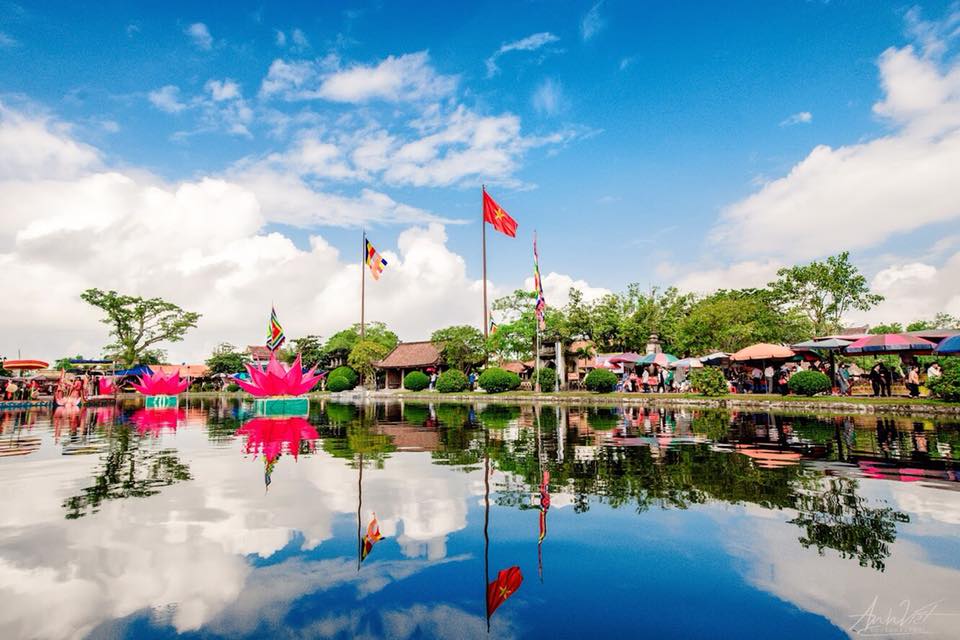Efforts in Preservation :
1. Restoration and Conservation Projects
- Restoration project (2006-2016): Over 25 billion VND was invested from the state budget and social contributions to restore important structures, including:
- The bell tower: One of the most iconic features of Keo Pagoda, its roof and wooden components were reinforced while maintaining the original design using traditional techniques.
- The Buddha statues: Wooden statues within the pagoda were cleaned and gilded using traditional lacquer and gold leafing methods.
- The pagoda grounds: Pathways, ponds, and green spaces were upgraded to preserve the harmonious landscape of the heritage site.
- Periodic inspections: Each year, the Heritage Management Board conducts detailed inspections and reports on the pagoda's condition to plan specific maintenance measures. This ensures the structure remains intact and retains its authenticity.
2. Protection of Ancient Artifacts
- Preservation of national treasures: Keo Pagoda houses numerous invaluable artifacts, including bronze bells from the Le Dynasty, stone steles inscribed with Chinese characters, and decorative plaques. These items are preserved in controlled environments to prevent damage from humidity or decay.
- Restoration of carvings: Wooden carvings on doors and roofs have been restored using traditional techniques to maintain their artistic value.
3. Cultural Promotion through Festivals
- Keo Pagoda Festival: Held annually from the 13th to the 15th day of the 9th lunar month, the festival honors Saint Dương Không Lộ and features traditional ceremonies such as processions, folk singing, and traditional games. The event attracts thousands of visitors, generating revenue for preservation efforts.
- Heritage promotion: Videos and publications highlighting the history and architecture of Keo Pagoda are widely disseminated to raise public awareness of heritage conservation.
4. Digitization and Research
- Heritage digitization project (2019): Detailed drawings and 3D models of Keo Pagoda have been created for digital storage, making it easier for researchers to access information about the site.
- Historical and architectural research: Research institutions have collaborated with Thai Binh authorities to publish books and reports about Keo Pagoda, providing a scientific foundation for preservation plans.
5. Collaboration and Resource Mobilization
- Cooperation with UNESCO: International organizations have provided technical assistance and advice on sustainable preservation methods, particularly in termite prevention and wooden structure protection.
- Social resource mobilization: The Heritage Management Board has launched community fundraising campaigns, receiving support from local residents, overseas Vietnamese, and organizations both domestically and internationally.
6. Heritage Protection Policies
- Strict zoning regulations: The area surrounding Keo Pagoda is zoned and monitored to prevent construction or industrial activities that could impact the site.
- Inclusion in educational curricula: The history and value of Keo Pagoda are included in educational programs in Thai Binh to instill pride in the heritage among younger generations.
Visitors’ contribution :
1. Participate in Volunteering Activities :
Visitors can join cleaning campaigns to maintain the cleanliness and beauty of the pagoda grounds. During major festivals like the Keo Pagoda Festival, volunteers can assist with event organization, guide visitors, or support traditional rituals. Additionally, those knowledgeable about the history and architecture of Keo Pagoda can volunteer as cultural guides, sharing its value and stories with others.
2. Contribute Financially :
Visitors may donate directly at the donation boxes within the pagoda, ensuring that the funds are allocated to maintenance and restoration. They can also support community-driven preservation projects through official channels. For those with greater resources, sponsoring specific preservation activities, such as restoring Buddha statues, conserving artifacts, or improving smaller structures in the complex, is another meaningful way to contribute.
3. Practice Responsible Tourism :
Respecting the pagoda’s regulations is essential. Visitors should dress modestly, maintain silence in worship areas, and avoid touching fragile artifacts or wooden structures. They should also avoid littering and opt for environmentally friendly products like reusable water bottles. Furthermore, minimizing harmful impacts, such as refraining from climbing on architectural structures or entering restricted areas, helps protect the site.
4. Spread Awareness about Preservation
Sharing positive experiences, photos, and stories about Keo Pagoda on social media can inspire others to appreciate and protect the heritage site. Visitors with innovative ideas for preservation can suggest them to the Heritage Management Board or local organizations to improve conservation efforts. By spreading awareness, they contribute to a broader culture of heritage appreciation.
5. Engage in Educational and Cultural Programs :
Learning about the history and cultural significance of Keo Pagoda through guided tours or workshops helps visitors understand its value more deeply. Providing constructive feedback on how to improve tourism and preservation efforts can also benefit the pagoda. By participating in these activities, visitors become advocates for the ongoing protection of this invaluable heritage site.
!["[KTMH] Trailer | WHAT TO DO TO MAKE SUMMER HOLIDAYS MORE MEANINGFUL?"](https://i3.ytimg.com/vi/s0VUGa1v6uw/maxresdefault.jpg)
